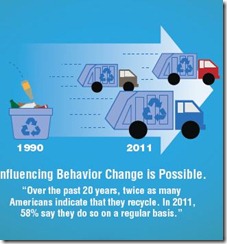Regardless of where a person works, whether in the private, public or nonprofit sector, one of the challenges of management is to help people understand the need for continuing and never-ending improvement.
Far too many people seem to want to go on autopilot and view any questioning of the status quo as personal criticism. Far too few seem to accept that if a project or product is successful, a measure of that success will be the need for continuing and never-ending improvement.
Take recycling, for example. Nationwide, twice as many Americans are recycling today compared to the percentage of people who did so two decades ago. The national average in 2011 was 58%, which is about what it was in Durham, where I live before we recently adopted 95 gallon rollout recycling containers.
Now the percentage here is closer to 85% or 90%, although the transition took a lot of work and I'm sure there was plenty of resistance from the “if it ain't broke” types who thought those little carry-out totes worked just fine.
When we observe such success, it is natural to wonder when will more things be recyclable? We also wonder when will we have the choice to downsize to one of smaller rollout waste containers (a process known as reverse recycling) that are available in many other communities, even if phased in gradually for new move-ins or as replacements for any that are broken during pickup which judging from my street alone must not be all that infrequent?
Those questions may feel like criticism to people who worked so hard just to get it to this point but they really shouldn't be construed that way. They are the natural result of being successful. People want to recycle more and throw away less, which was the goal all along.
Take small electronic items for example. In Durham the city will swing by and pick up large, bulky items, but residents are asked to hold on to the smaller items and bring them to episodic events for recycling. The events have been a huge success.
Residents have queued up at six events over just the past two years and have recycled 149.13 tons of electronics or nearly 300,000 pounds, or about 1.5 pounds for every adult resident city. Impressive it seems and this doesn’t include the tons of electronics that are recycled as trade=ins by retailers such as Staples and Best Buy.
But that begs the question as to when residents will be able to just put the small electronics in their recycling rollout cart every other week instead of stockpiling them and then queuing up at special events specially created to collect them.
All recycling items go through a sorting stage anyway so even if electrical items are not handled by the same vendor that processes the other recyclables, electronic items could still be placed off to the side in a bin at sorting sites to be picked up by the same vendor that collects them at the special events.
Even if it takes a while to reach the level of mass at which this is feasible or to work out the logistics, residents would still be relieved to know that the process is being evaluated and that the two types of collection will eventually merge in the near future making it possible to handle electrical items much more conveniently.
The City has done an excellent job of teaching residents to recycle and making it increasingly convenient to do so. To sustain and increase that enthusiasm it is important for residents to be able to envision that more and more things will be recyclable and that there will be recycling containers placed in more and more places, including city parks, airports, schools, etc.
Enough will never be enough and the job will never be finished until either everything is conveniently recyclable and there is absolutely no need for land fills or, as is currently under development and full-scale testing, new processes are scaled up to convert all un-recyclable waste into energy.
Until then questions should be taken as suggestions rather than criticism. Questions are a sign that people are engaged in the objective of continuing and never-ending improvement.
No comments:
Post a Comment